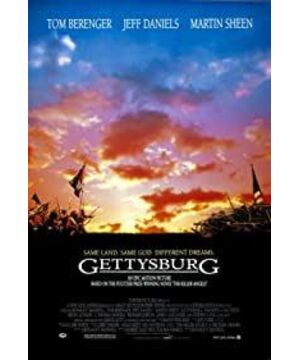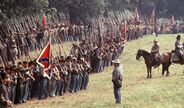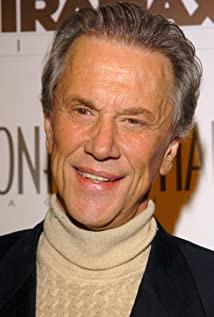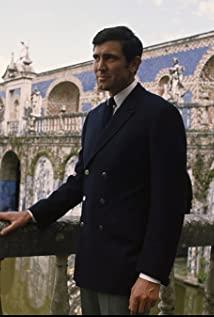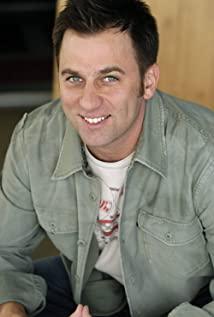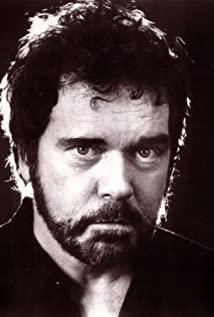My Apple computer broke down in the last two days, so I had to send it for repair. Originally, movies were all watched on the 27-inch screen of the computer. Without a computer, you wouldn't be able to see a movie. Of course, there would be no sense of afterthought. When I was depressed, I suddenly had an idea and connected my external hard drive to the TV set-top box. It was really amazing. You can basically watch the movies above, but there are no new movies. In addition to watching more than a dozen episodes of the "Western World" TV series, I only watched the "Battle of Gettysburg" filmed in 1993.
The film is four and a half hours long. It is about a turning battle during the American Civil War. When it comes to the Civil War, the reasons are complicated. The origin is the independence movement in the south and the anti-separatism in the north. The widely-recognized abolition of slavery is only one of the factors, not its root cause, at best, it is a driving force for the development of war. There are other political, economic, and religious reasons. After the war, people had general reflections. To this day, the question of who is right and who is wrong in this war has not ceased to be debated. Therefore, unlike the motives of other wars, there is no clear boundary between aggression and counter-aggression, dictatorship and anti-dictatorship, and oppression and counter-oppression. Watching this movie cannot presume a standpoint. Both sides of the war are people with ideals and beliefs.
The film focuses on three typical events in the battle. Through these events, we have a glimpse of the battle.
The first is the decision-making process of the Southern Army. General Li's failure was due to two mistakes. The first was to underestimate the enemy. The army he led has always been invincible and defeated the Northern Army. On the first day of the Battle of Gettysburg, the Southern Army won a small victory. It made him dizzy. Violated the taboo that the arrogant soldier must be defeated. The second is that the enemy's situation is unknown. He sent the love general Stewart to lead the cavalry to detect the enemy's situation. As a result, this man was not in the war zone two days after the start of the battle! The film described the scene of General Lee furious with the returning Stewart, but it was obviously too late. In all fairness, General Lee is a rare military talent, once served as the principal of West Point Military Academy. In the Northern Army and Southern Army, his peaches and plums are all over the world. Old tactics and careful thinking. The morale of the troops he brought was also very strong. But helplessly, this time God is standing in the north. When General Li knew that the defeat was set back to the sky, he said to his men and all the soldiers: "It's all my fault!" I don't know what other commander on the battlefield can have such courage and responsibility?
The second is the small dome defense battle of the 20th Maine Regiment of the Northern Army. The small dome is the commanding height of the entire northern defense line and the key to the entire position. If the Battle of Gettysburg was a turning point in the American Civil War, then the victory of the Little Dome battle was a turning point in the Battle of Gettysburg. Guarding the small dome is the 20th Maine Regiment, and the leader is Chamberlain, who is a scholar. Although he was born in a non-military class, he has a firm belief in fighting for freedom and affects everyone. He had only 385 troops on hand. Under the fierce attack of the southern army, the line of defense almost collapsed, and as a result, it just supported it. Almost all casualties of the entire regiment, with fewer than 80 people unharmed. When the southern army showed signs of charging again, Colonel Chamberlain realized that it was impossible to defend this time. At this time, Chamberlain asked all the soldiers under him to mount bayonets, and everyone stood in a row, and led all sound troops to rush down the hill. As a result, the unexpected frontal offensive made the Confederate army who did not know what to do on the mountain suddenly bewildered and retreated. So in this dramatic charge, the southernmost end of the line of defense was safe.
The third is the famous Pickett charge. On the last day of the battle, the Southern Army gathered all the artillery and prepared for nearly two hours of artillery fire on the Northern Army’s Cemetery Ridge position. Before the smoke was over, 15,000 soldiers from the Southern Army held their heads up and attacked in neatly small steps. All the division commanders took the command knife in one hand and the revolver in the other, leading the way and leading the team. At the end of the battle, these commanders were either killed or wounded. The northern army on the opposite side was heavily guarded and desperately resisted. On the open ground 1,000 meters in front of Cemetery Ridge, the corpses ran across the wild and blood flowed into rivers. Regarding the Southern Army, General Li and other high-level commanders knew that no matter whether they won or lost, these soldiers who had charged with death would not be able to return, and they still gritted their teeth and ordered them to move forward. The cruelty of the war is evident.
Throughout the battle, the Southern Army suffered 28,000 casualties and the Northern Army suffered 23,000 casualties. Responded to the phrase "Kill the enemy three thousand and hurt yourself eight hundred." In fact, the victory or defeat of a war cannot be reflected by the number of casualties. It depends on whether the expected strategic goals have been achieved. Since this battle, the Southern Army's vitality has been severely injured, and it has lost the initiative in the war. It has become the end of the battle.
The film is a true reproduction of the battle over 150 years. Let the audience understand how the war was fought at that time. Look at the weapons first. Soldiers basically use M1855 flintlock front-loaded muskets. We call them muskets. The rate of fire is slow and the accuracy is poor. As you can see in the film, take a shot, quickly charge the drug, and then use the system to force the shot before firing. Make the audience watching the movie extremely anxious. The hit rate is basically aimed at head spanking. To effectively kill the opponent, only increase the shooting density and aiming time. So there is a phalanx of the platoon infantry regiment. For artillery, the M1857 front-muffle field artillery is usually used, which is the so-called "Napoleon gun". The range is 1400 meters. It stands to reason that the shell of this artillery weighs 5 kilograms, and the power is not small. But the prerequisite is to play accurately to produce power. Because it is a smoothbore gun, the accuracy is very poor. Observation and communication equipment is also very rudimentary. Basically rely on the mouth and ears. The Southern Army prepared for two hours of artillery fire before carrying out the Pickett charge, but it had no effect on the Northern Army's combat power. By comparison, I myself participated in the battle against Guangxi in 1979. Among the artillery I participated in, the range was usually more than 10 kilometers. The artillery fire was prepared for 45 minutes, and the enemy's combat power was damaged by 40%.
Look at the formations. In the movie, both the offensive and the defensive sides are in a dense formation, with people next to each other, and the officers marching in unison chanting commands. It is only two to three hundred meters from the attacking starting position to the opponent's defensive front. It's completely the opponent's live target. In fact, it is helpless to adopt this formation. I mentioned platoon gun shooting, and the firepower density and personnel density were the same at that time. The communication method mainly relies on the commander's roar, and it will become inaudible if it is too scattered. Due to the short range of the artillery, the position can only be arranged tens of meters behind the infantry. The infantry commander can tell the artillery where to fight as soon as he turns his head. A total of 680,000 people died in the American Civil War, more than the total number of deaths in all wars since the US military. It was these bloody experiences that led to the subsequent offensive formation of the front and back triangle.
I have watched some of these war epics. Similar to the former Soviet Union's "Liberation" and "The Defense of Moscow", Japan's "The Great Battle in the Sea of Japan", China's "Three Great Battles" and so on. Compared with the latter, "The Battle of Gettysburg" is more thoughtful in dealing with the overall and local relations. Although there are few grand scenes of that kind, they also reflect the real conditions of the battlefield at that time. There are also unique features in the details. The way of fighting, the bright military uniforms, the camping tents, the two sides fight in blood and flesh. It fully demonstrated the cruelty and tragic of the war 150 years ago.
My score: 7.5.
View more about Gettysburg reviews


